
In the late Forties and early Fifties, Chrysler was considered a luxurious, well-engineered, high powered (starting in ’51 with the FirePower V8) line of cars. But at the same time, boring and staid.
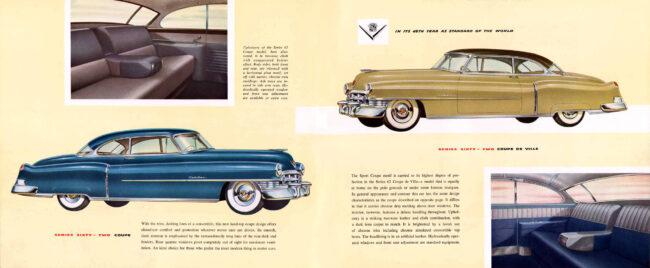
They weren’t nearly as smooth and sexy as, say, a ’50 Coupe de Ville. Not that they were ugly, but they were a little vanilla compared to some other makes.

But starting in 1955, that all changed. Virgil Exner, late of Raymond Loewy & Associates and Studebaker Corporation, was out to make his mark in the automotive world. By all accounts, he succeeded.

In the late 1940s, Virgil had gotten himself into trouble with Loewy & Associates, where he was assisting with the styling of the all-new postwar Studebaker line. According to Richard Langworth’s excellent book Studebaker 1946-1966: The Classic Postwar Years (I highly recommend obtaining a copy of that book, by the way), while designing the new 1947 Studebaker, Exner allegedly colluded with Studebaker staff, particularly chief engineer Roy Cole (who didn’t take kindly to Loewy and his consulting form, for a myriad of reasons), to come up with an alternate design.
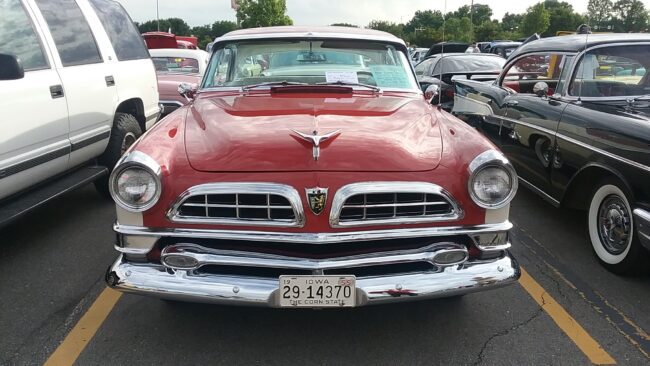
Though not drastically different from Loewy’s design, Studebaker executives chose the in-house design but kept Loewy involved, so as to use his name for sales cachet. Loewy was not pleased with his employee’s attempted glory-hogging, and old Virge was–you guessed it! Fired. In addition, Loewy had enough clout to make Studebaker uncomfortable enough not to hire Exner themselves (note to self, do NOT screw with Raymond Loewy), so he eventually wound up at Chrysler Corporation in 1949.

The 1949 Chryslers were all-new, but stodgy and tall and narrow, designed for people who liked to wear hats while driving. Engineering was good, but the cars were plain vanilla next to other models like the Olds Rocket 88, Buick Roadmaster, and ’49 Ford and Mercury. The 1953-54 Big Three sales war resulted in a remarkable upset; Chrysler Corporation, who had been number two in sales after GM for years, suddenly found themselves behind Ford in third place. Clearly, something had to be done.
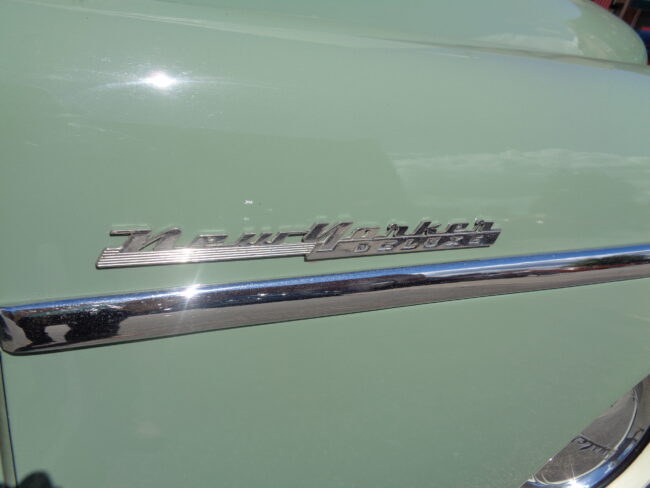
What was done was a remarkable transformation of all Chrysler automobiles, from entry-level Plymouth to the new Imperial, now its own marque and no longer a deluxe Chrysler. The “banker’s hot rod” 300 was also big news when it was introduced in February of ’55 as a mid-year model, tearing up the sand at Daytona and easily trouncing everything in sight.

This new styling direction was called the “Hundred Million Dollar Look” (cue Dr. Evil laughter!), as that is what the cars allegedly cost Chrysler to design, engineer and put into production. It may have been worth it. Suddenly the once-dowdy Plymouth Savoys and Dodge Royals looked attractive to many new buyers, no longer something only your Aunt Gert and Uncle Fred in Des Moines would drive.
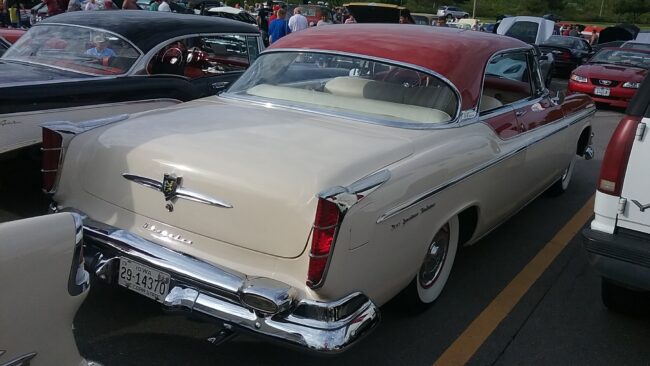
Even the Windsor Deluxe, the least-expensive Chrysler, was very attractive. In fact, as with many cars in the mid to late Fifties, the more basic versions were perhaps more elegant and pure than the increasingly bechromed, two- and three- tone models that appeared as you got into the fancier models.
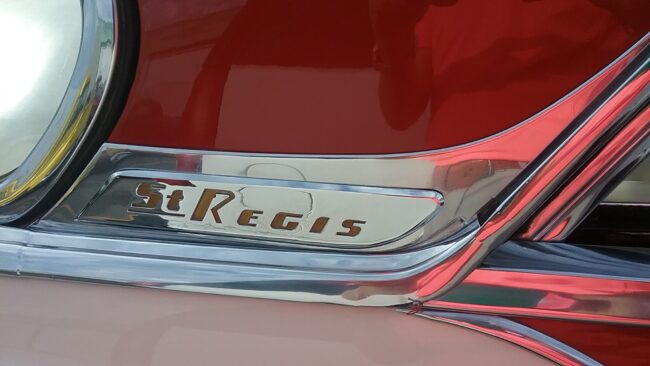
While all ’55 Mopars looked great, Chryslers were particularly attractive, with suitably deluxe accommodations. Our featured model is a New Yorker Deluxe St. Regis, sporting an attractive red and white two-tone treatment inside and out. ’55 Chryslers (and their near-identical DeSoto brethren) also had a particularly attractive instrument panel, looking like something out of a Chris Craft Capri or Century Coronado speedboat.
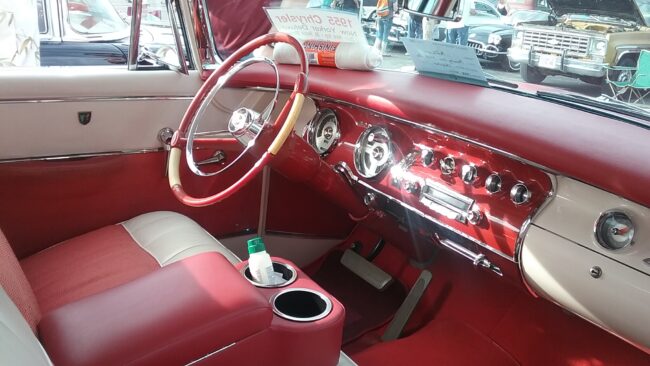
Other than the rarefied 300 hardtop, the top of the line Chrysler was the New Yorker Deluxe, offered in four door sedan, two door hardtop, convertible and Town & Country wagon versions. The rarest 1955 Chrysler was the New Yorker Deluxe convertible, of which a mere 946 found homes. The two-door Windsor, New Yorker and 300 were the only pillarless models offered that year, though a four-door hardtop would appear for ’56.
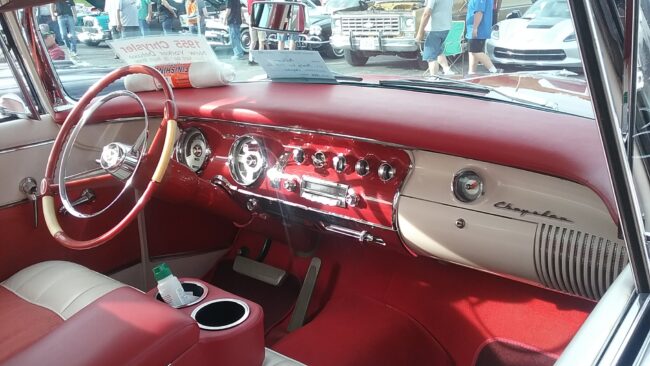
You could get your NY Deluxe hardtop in two versions, the standard $3652 Newport, or the slightly fancier $3690 St. Regis, which wore (of course) additional chrome trim, providing a very unique two-tone pattern, as seen here. Chrysler buyers apparently preferred it to the plainer NYD hardtop, to the tune of 11,076 St. Regises vs. 5,777 ‘regular’ NYD hardtops.
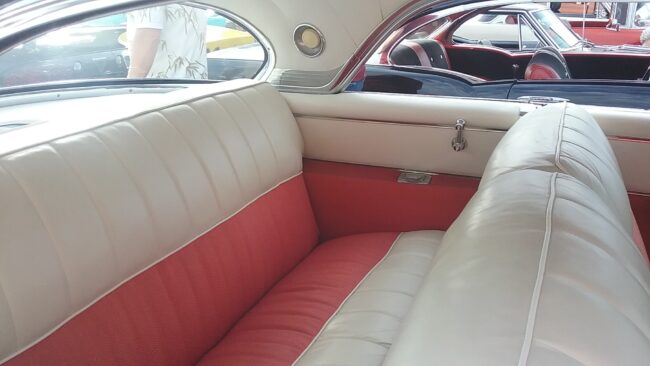
All Chryslers had a V8, regardless of trim level, Windsors with a new 301 CID version with 188 hp and New Yorkers retaining the excellent 331.1 CID Hemi V8 with 250 hp. As befitting its name, the 300 got a souped-up 300 hp version of the 331 mill.
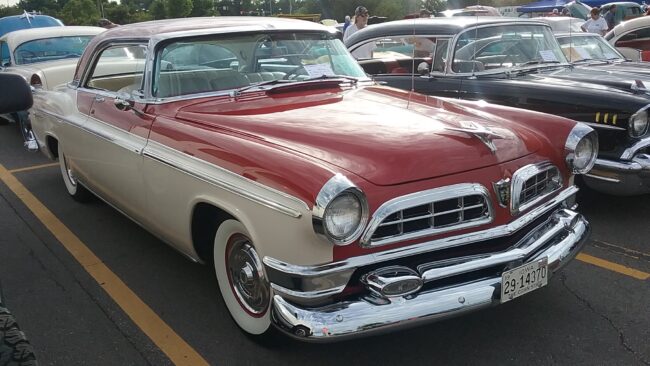
All in all, Chrysler had a good year in 1955, undoubtedly helped by the fresh, attractive styling and proven Hemi power on the upper-level versions. Chrysler actually was second place among high-end marques for 1955, though the company as a whole remained in third place, behind GM and Ford.

Our featured vehicle was spotted at one of the Classy Chassy car club’s cruise nites at Coral Ridge Mall, in the greater Iowa City/Coralville area. I typically meet up with my aunt and uncle, who are locals, we gawk at the cars, then we go to either Pagliai’s pizza or some other excellent local dining establishment, then I drive home and fall asleep on the couch, ha ha. I’ve been seeing this car for years, but despite that I still have to wander over and gawk at it. It’s so nice. And such a terrific color combo.
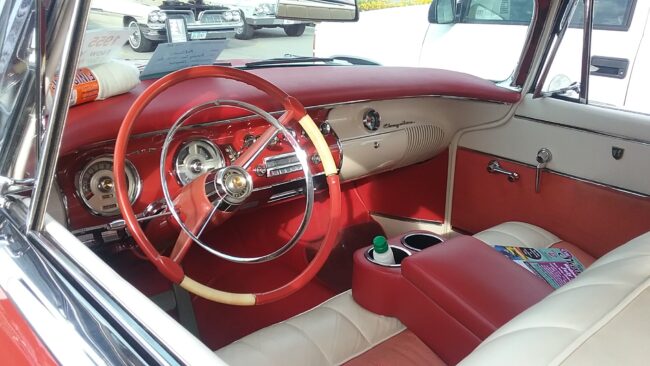
As for Virgil, he would hit another home run with his “Forward Look” cars iof 1957. If it wasn’t for the rush to production and the resulting shoddy assembly quality and rust issues of those cars, perhaps Chrysler wouldn’t have abandoned the look for the bizarre styling of 1960-62 Mopars. For Virgil, time was running out.







13 Comments
WOW ! I really like that two tone paint .
Many years ago my friend Greg S. had a ’56 (IIRC) Chrysler Windsor two door hard top, his father’s car, in the late 1970’s it was just one more old MoPar but I liked it plenty .
-Nate
They really were nice cars. Friend of mine’s father would ONLY by the New Yorkers.
Off on a little tangent here, but that ad for the 1951 Chrysler engines caught my eye. Not so much the hemi V8 but the other engine in the Windsor, the “Spitfire” inline six. Looking it up, it was a flathead of about 4 liters that made 116 gross horsepower. The ad copy said it was the best 6 cylinder engine ever designed. In period ad copy isn’t supposed to be funny so I assume they mean it’s ability as a long lasting workhorse.. Six cylinder durability at Chrysler has always meant to me slant 6 or maybe the 3.3/3.8 V6s. Does anybody know if the Spitfire had a similar reputation back then?
The 251 flathead 6 was used as one of 5 in the Chrysler A57 multibank tank engines in WWII. From what I’ve read it was pretty reliable in that usage.
Interesting, I knew the Sherman tanks were more reliable that the panzers or the Matildas, but I thought they had a diesel.
American and German tanks used gasoline. The Soviets used diesel in the famous T-34. Seems surprising as it must have made things more difficult logistically.
One reason the Sherman silhouette was so tall is that early models used an aircraft radial as the engine. The driveshaft leading to the transmission in the front had to be routed under the turret basket, meaning it ended up higher than was perhaps ideal.
Man, those are gorgeous.
Instrument panels on this generation of cars were so cool. So many interesting shapes and colors and now all we get is black plastic. Sometimes the plastic shapes are neat, or covered in black leather which is fine I suppose, but nothing particularly stylish. My CX-5’s interior would be vastly improved if the glossy black panel across the right side of the dash was replaced with a body-color one (so long as your boring car isn’t gray scale this would work in any model). But no. Black plastic everywhere.
IIRC the original ‘Spitfire Six’ was a DeSoto engine, the metal spark plug wires tube was so stamped .
MoPar FlatHead 6 cylinders were indeed very good engines but didn’t like high RPM operation for extended use .
The simple solution would ave been to equip all cars with overdrive but highway speeds were *much* slower back then .
-Nate
Holy Smokes- we have to push the advent of cup holders back another two decades!
I’m starting to think Tom is making sport of me with that maroon aftermarket console.
Beautiful car.
Totally unintentional, but I did notice it had them when I was loading the pics, ha ha.
Those things are REALLY popular.
In case anyone cares of needs parts, there’s a nice looking ’55 Chrysler two door in the LKQ self service junkyard on Katella in… Anaheim or Stanton, Ca.
Most of the front sheet metal is already gone .
-Nate
In case anyone cares or needs parts, there’s a nice looking ’55 Chrysler two door in the LKQ self service junkyard on Katella in… Anaheim or Stanton, Ca.
Most of the front sheet metal is already gone .
-Nate